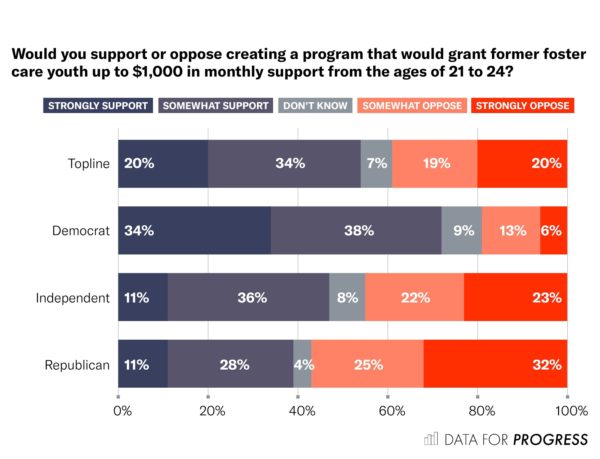The Case for Providing Guaranteed Income to Kids Aging out of Foster Care
With soaring unemployment, stagnant wages, and historic income inequality, the transition from living at home to financial independence is often a long and arduous one, and perhaps impossible without a family safety net. That transition is even more difficult for children in foster care.

Introduction
More and more in America, young adults rely on their parents and other relatives for housing and financial support well into their 20s. That trend was already growing, and now the COVID-19 pandemic and dire economic conditions have further increased the need for young adults to lean on their families for resources. With soaring unemployment, stagnant wages, and historic income inequality, the transition from living at home to financial independence is often a long and arduous one, and perhaps impossible without a family safety net.
That transition is even more difficult for children in foster care. Foster children face disadvantage from the start—they are more likely, for example, to become entangled in the criminal legal system, and less likely to graduate from college—and those who age out of the system without placement into a permanent home are abruptly abandoned, left to fend for themselves between the ages of 18 or 21. The government functions as their parent, and then swiftly extinguishes financial support, depriving foster kids of the safety net that so many of their peers increasingly find necessary. This added disparity compounds the systemic disadvantage that foster kids already endure, and puts them at heightened risk for poverty, homelessness, and incarceration.
States and localities can address this crisis by providing a regular stipend to young people as they transition from child welfare systems to life as independent adults. Direct cash payments are immediate and flexible. Recipients can apply payments to their most pressing needs, and the stipends are not, nor should be, encumbered by restrictions like unemployment. A regular income pays for basic needs like education, groceries, rent, or healthcare, depending on the person’s circumstances at the moment. For young people who suddenly find themselves without a meaningful support system, this type of initiative can be a lifeline, with benefits for both the recipients and their communities.
A Unique Crisis: The Vulnerability of Children in the Foster Care System
When children cannot stay in or return to their homes, the child welfare system works to find them another permanent home through adoption or legal guardianship before they become adults. But the system often falls short. In 2018, the United States had over 437,000 children in foster care, approximately 17,000 young people left foster care for no reason other than their age, and over 12,000 remained in care as young adults between their 18th and 21st birthdays.
Foster children, on average, have worse outcomes as adults than their peers across a range of indicators. Young adults who age out of foster care are more likely to have criminal justice involvement and become parents at an early age, they generally earn less than their peers, and they are more likely to suffer economic hardships. And while youth in foster care have the same educational aspirations as their peers (over three-quarters of 17-18 year-old foster children say they want to attend college), less than 10 percent of them complete a bachelor’s degree, compared to a national rate of about 30 percent.
These relatively poor outcomes are not surprising. Children in foster care overwhelmingly come from low-income families living in marginalized communities that suffer from the effects of systemic racism. They enter care because the state assesses their parents as being unable or unwilling to adequately care for them, most often due to perceived neglect of their basic needs as a result of poverty, but in some cases due to physical or sexual abuse. Among those who age out of foster care, most entered the system at a later age, in some cases after many years of trauma and deprivation at home. As a result of this trauma, these children are often behind their peers developmentally when they enter care, and adolescents may be years behind. From a physical health perspective, foster children have higher rates of “physical, developmental, dental, and behavioral health conditions than any other group,” according to the American Academy of Pediatrics. Additionally, a review of research on older adolescents in foster care found that they are 2 to 4 times more likely than their peers in the general population to have mental health disorders.
Foster Children Need Support Into Adulthood
The federal government has increasingly recognized the moral imperative of supporting foster care children into adulthood. For instance, the John H. Chafee Foster Care Independence Program provides funds to help with everything from education to emotional support, and it authorizes Congress to provide states and tribes with training vouchers of up to $5,000 per year for youth likely to experience difficulty as they transition to adulthood. In addition, the Fostering Connections to Success and Increasing Adoptions Act provides federal funding to states that extend foster care up to age 21. To date, 28 states and the District of Columbia have taken up the option to extend care. In light of pandemic-created hardships, some states have gone further, using their own funds to allow youth to remain in care past their 21st birthday during the pandemic.
Research shows that continued support leads to better outcomes. States that have extended care to age 21 have found that the vast majority of youth in their care choose to remain in care well past their 18th birthday, and available evidence suggests that remaining in care increases the likelihood of favorable outcomes for young people transitioning from foster into adulthood (for example, educational attainment, employment and earnings, and adequacy of social support are improved) and decreases the likelihood of poor outcomes (for example, homelessness, economic hardship, and criminal legal system involvement).
But research has also shown, not surprisingly, that abruptly ending support on a youth’s 21st birthday—or, worse, at the age of 18—abandons young people when they still need assistance. Ending support at 21 ignores the continuing threat of homelessness for these young people, cuts them off from aid for their continuing education when many of them are still in school, disrupts the continuity of access to mental health services for those coping with their histories of trauma, and plunges many young parents and their children into poverty.
Guaranteed Income Programs Can Help Bridge the Gap
Santa Clara County, California recently launched a pilot program to provide a “no strings attached” monthly payment of $1,000 for former foster youths between the ages of 21 and 24 for up to one year. The program prioritizes eligibility based on age, and for 2020-21, the program will serve the 72 young adults who have turned 24. The program is a partnership between the county and private funders, and includes a plan to track and evaluate the program’s effectiveness. The initiative includes check-ins and financial counseling from county staff every three months. This Santa Clara program is the first of its kind to offer basic financial support beyond the age of 21 and hopes to serve as a model for future programs across the country.
According to Santa Clara County Supervisor Cindy Chavez, the pilot program originated with the belief that children in the county’s custody should be cared for as if they were her own, or the children of other local parents. Chavez characterized the program as being about justice, not charity. “When you’re making investments in justice, you’re launching human beings to reach their highest capacity,” she told TalkPoverty.org. While not sufficient to meet all of these young adults’ financial, social, and emotional needs, a basic income program gives them a chance at solvency and a stable future.
Local guaranteed income programs, like the Santa Clara County pilot, provide regular, direct cash payments to individuals with financial need. Unlike universal basic income, these programs are targeted by need, and unlike many government assistance programs, they are unconditional. Direct cash payments give people an immediate, flexible resource that they can use to meet their most urgent needs, which may vary month to month based on their circumstances. And because guaranteed income programs are not contingent on unemployment, they also facilitate participation in the job market—a critical component for young people transitioning out of foster care into adulthood, who often do not have a back-up support system for housing, food, healthcare, and other basic needs.
These local-level stipend programs are widely popular. Polling by Data for Progress and The Lab, a policy vertical of The Appeal, shows that 59 percent of likely voters, including 78 percent of Democrats, 54 percent of independents, and 40 percent of Republicans support piloting local guaranteed income programs that provide direct cash payments of $500 to $1,000 per month to people in need.
New polling from Data for Progress and The Lab shows that a majority of voters also favor a guaranteed income program for young adults transitioning out of foster care.

Conclusion
It is increasingly common for young people between 18 and 24 to live with their parents or in the home of a relative, a trend particularly heightened during the pandemic and resulting economic hardship. Many young adults rely extensively on their families for financial support. But children transitioning out of foster care often lack a similar support system, and they are uniquely vulnerable to dire outcomes like homelessness, criminal legal system involvement, and deep poverty. While it should be the goal of every state to extend care up until at least a young person’s 21st birthday, this cutoff still leaves former foster children in a precarious position without basic resources. Providing these children with a regular income while they transition from state care into the adult world has the potential to give them a more stable, secure future.
Polling Methodology
From Jan. 29 to Feb. 1, 2021, Data for Progress conducted a survey of 1,124 likely voters nationally using web panel respondents. The sample was weighted to be representative of likely voters by age, gender, education, race, and voting history. The survey was conducted in English. The margin of error is ±2.9 percentage points.
Mark Courtney is the Samuel Deutsch Professor at the University of Chicago. Shanta Trivedi is a Clinical Teaching Fellow at Georgetown University Law Center.

